Information Technology Applications and AI Impact on British Airways
VerifiedAdded on 2023/06/15
|11
|2662
|279
Report
AI Summary
This report provides an overview of Information Technology applications within businesses, focusing on a case study of British Airways. It details various types of application software used to enhance business performance, including accounting, presentation, CRM, inventory control, spreadsheet, word processing, payment transaction, database, and multimedia software. The report also addresses ethical and social issues in the digital world, emphasizing transparency, integrity, and ethical values. Furthermore, it examines the impact of Artificial Intelligence on business operations, such as saving time and costs, enhancing productivity, increasing revenue, preventing errors, and providing customer service through chatbots. The report outlines the stages of the Software Development Life Cycle, including planning, analysis, design, development, testing, implementation, and maintenance. Finally, it discusses the benefits and drawbacks of investing in information technology, specifically within the airline industry, highlighting improvements in connectivity, traveler experience, and operational efficiency, while also noting potential over-reliance on technology. Desklib provides access to similar solved assignments and past papers for students.
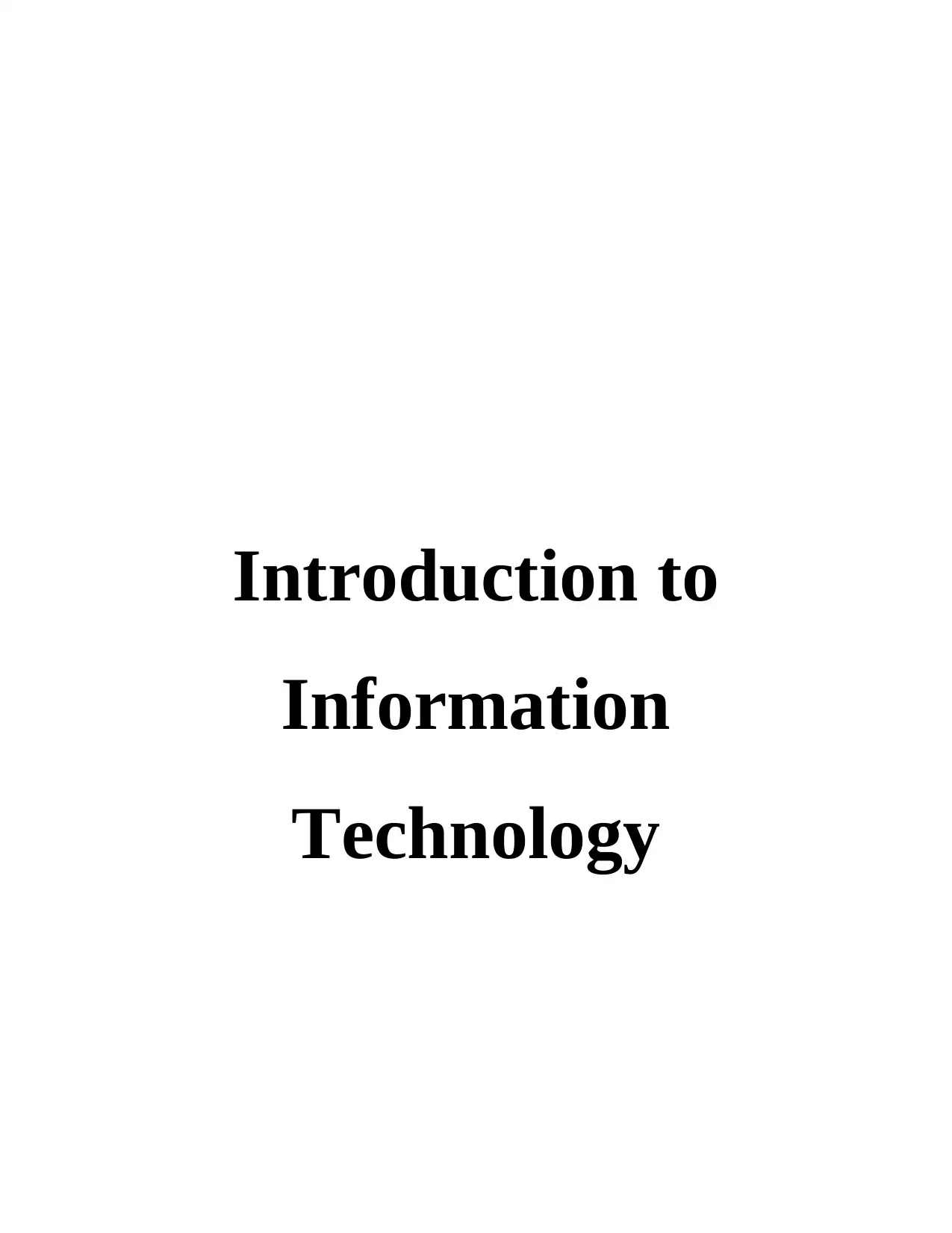
Introduction to
Information
Technology
Information
Technology
Paraphrase This Document
Need a fresh take? Get an instant paraphrase of this document with our AI Paraphraser
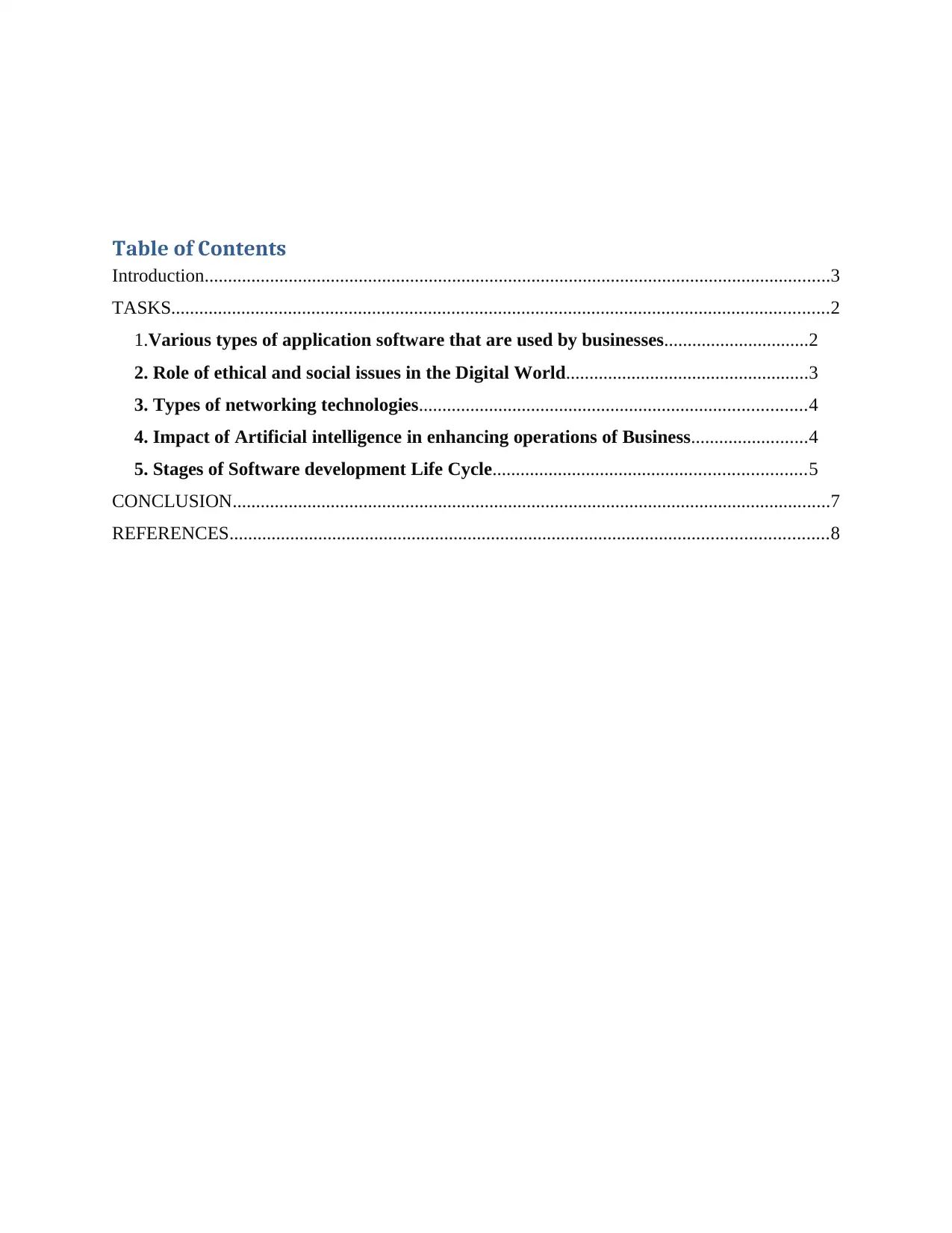
Table of Contents
Introduction......................................................................................................................................3
TASKS.............................................................................................................................................2
1.Various types of application software that are used by businesses...............................2
2. Role of ethical and social issues in the Digital World....................................................3
3. Types of networking technologies...................................................................................4
4. Impact of Artificial intelligence in enhancing operations of Business.........................4
5. Stages of Software development Life Cycle...................................................................5
CONCLUSION................................................................................................................................7
REFERENCES................................................................................................................................8
Introduction......................................................................................................................................3
TASKS.............................................................................................................................................2
1.Various types of application software that are used by businesses...............................2
2. Role of ethical and social issues in the Digital World....................................................3
3. Types of networking technologies...................................................................................4
4. Impact of Artificial intelligence in enhancing operations of Business.........................4
5. Stages of Software development Life Cycle...................................................................5
CONCLUSION................................................................................................................................7
REFERENCES................................................................................................................................8

Introduction
⊘ This is a preview!⊘
Do you want full access?
Subscribe today to unlock all pages.

Trusted by 1+ million students worldwide
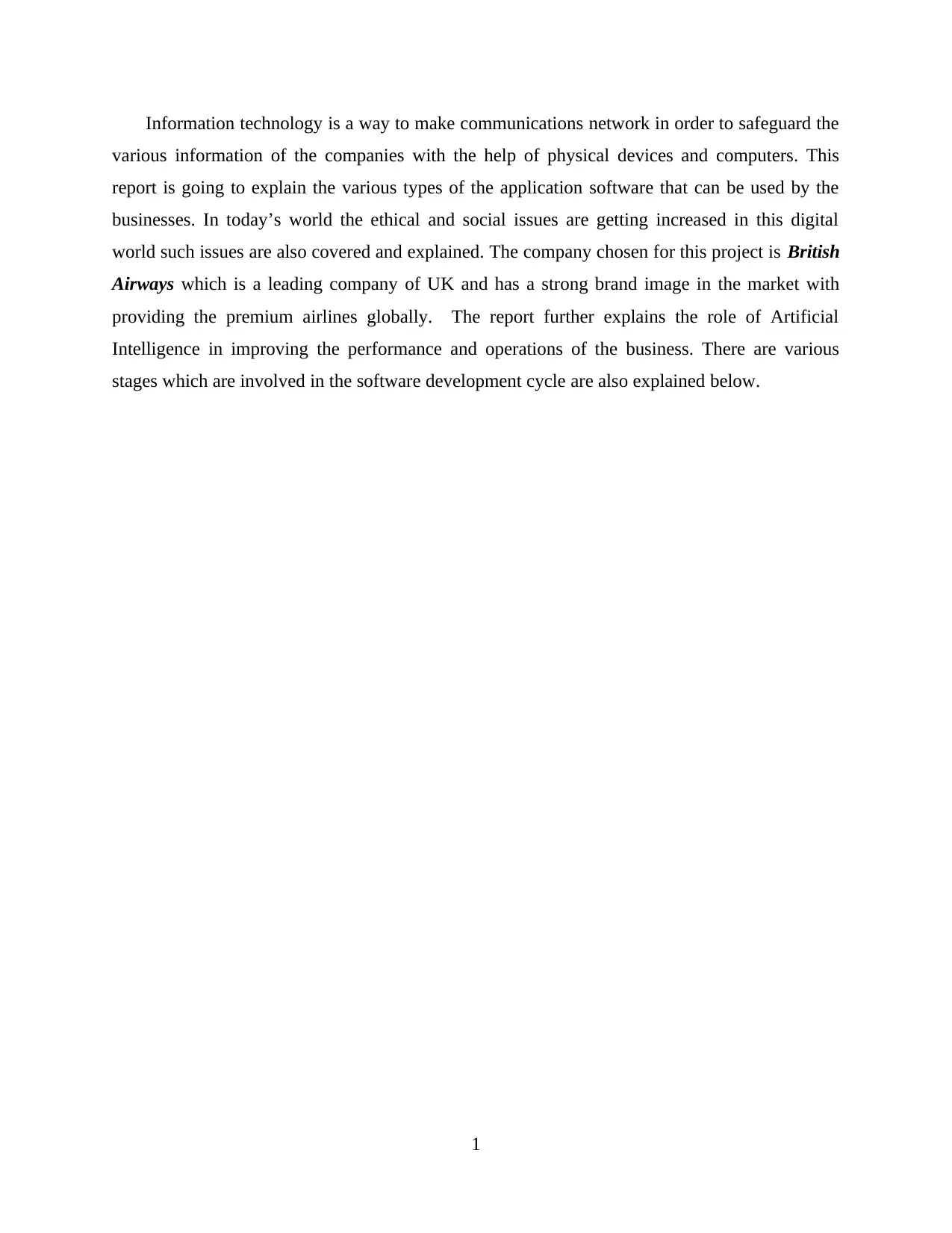
Information technology is a way to make communications network in order to safeguard the
various information of the companies with the help of physical devices and computers. This
report is going to explain the various types of the application software that can be used by the
businesses. In today’s world the ethical and social issues are getting increased in this digital
world such issues are also covered and explained. The company chosen for this project is British
Airways which is a leading company of UK and has a strong brand image in the market with
providing the premium airlines globally. The report further explains the role of Artificial
Intelligence in improving the performance and operations of the business. There are various
stages which are involved in the software development cycle are also explained below.
1
various information of the companies with the help of physical devices and computers. This
report is going to explain the various types of the application software that can be used by the
businesses. In today’s world the ethical and social issues are getting increased in this digital
world such issues are also covered and explained. The company chosen for this project is British
Airways which is a leading company of UK and has a strong brand image in the market with
providing the premium airlines globally. The report further explains the role of Artificial
Intelligence in improving the performance and operations of the business. There are various
stages which are involved in the software development cycle are also explained below.
1
Paraphrase This Document
Need a fresh take? Get an instant paraphrase of this document with our AI Paraphraser
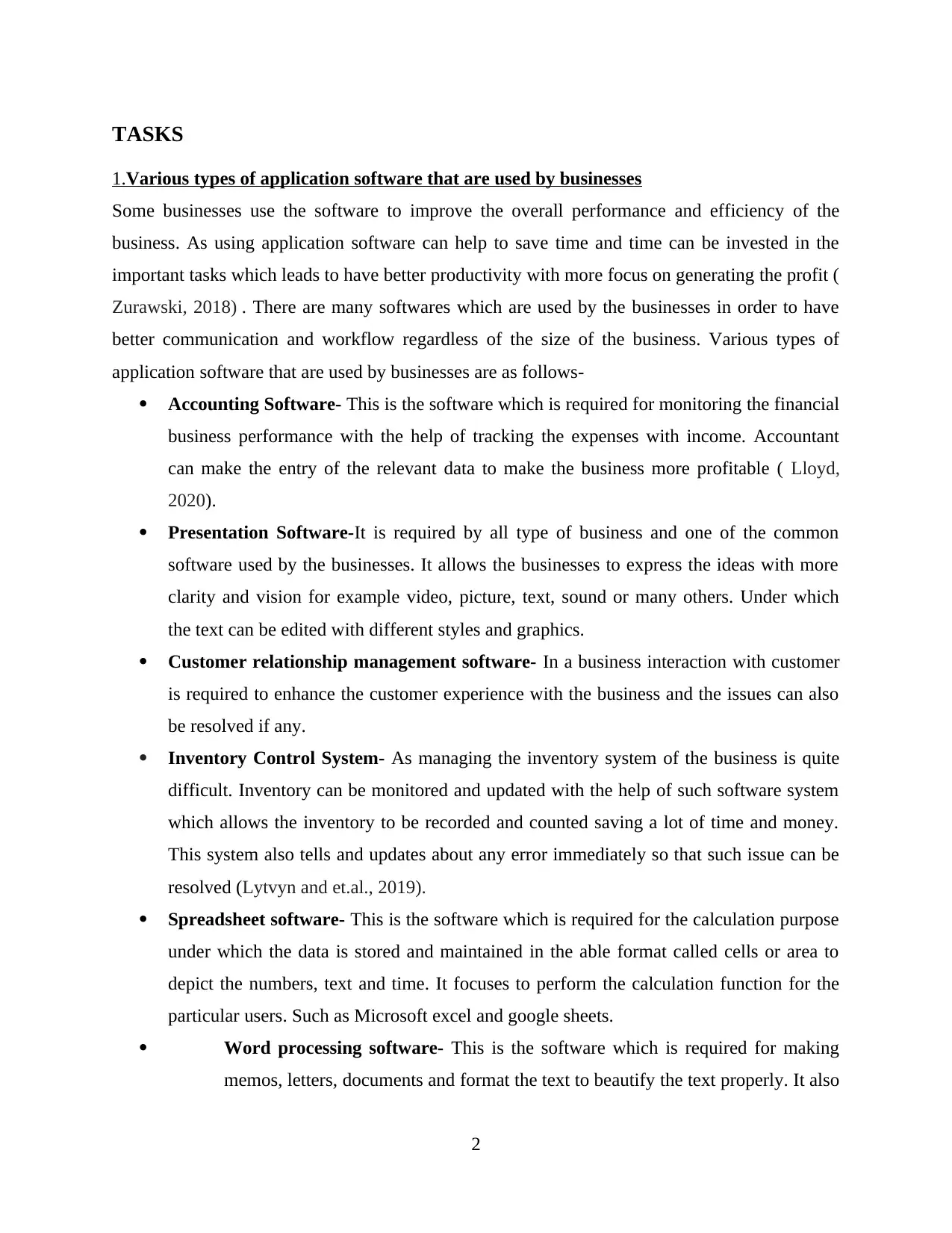
TASKS
1.Various types of application software that are used by businesses
Some businesses use the software to improve the overall performance and efficiency of the
business. As using application software can help to save time and time can be invested in the
important tasks which leads to have better productivity with more focus on generating the profit (
Zurawski, 2018) . There are many softwares which are used by the businesses in order to have
better communication and workflow regardless of the size of the business. Various types of
application software that are used by businesses are as follows-
Accounting Software- This is the software which is required for monitoring the financial
business performance with the help of tracking the expenses with income. Accountant
can make the entry of the relevant data to make the business more profitable ( Lloyd,
2020).
Presentation Software-It is required by all type of business and one of the common
software used by the businesses. It allows the businesses to express the ideas with more
clarity and vision for example video, picture, text, sound or many others. Under which
the text can be edited with different styles and graphics.
Customer relationship management software- In a business interaction with customer
is required to enhance the customer experience with the business and the issues can also
be resolved if any.
Inventory Control System- As managing the inventory system of the business is quite
difficult. Inventory can be monitored and updated with the help of such software system
which allows the inventory to be recorded and counted saving a lot of time and money.
This system also tells and updates about any error immediately so that such issue can be
resolved (Lytvyn and et.al., 2019).
Spreadsheet software- This is the software which is required for the calculation purpose
under which the data is stored and maintained in the able format called cells or area to
depict the numbers, text and time. It focuses to perform the calculation function for the
particular users. Such as Microsoft excel and google sheets.
Word processing software- This is the software which is required for making
memos, letters, documents and format the text to beautify the text properly. It also
2
1.Various types of application software that are used by businesses
Some businesses use the software to improve the overall performance and efficiency of the
business. As using application software can help to save time and time can be invested in the
important tasks which leads to have better productivity with more focus on generating the profit (
Zurawski, 2018) . There are many softwares which are used by the businesses in order to have
better communication and workflow regardless of the size of the business. Various types of
application software that are used by businesses are as follows-
Accounting Software- This is the software which is required for monitoring the financial
business performance with the help of tracking the expenses with income. Accountant
can make the entry of the relevant data to make the business more profitable ( Lloyd,
2020).
Presentation Software-It is required by all type of business and one of the common
software used by the businesses. It allows the businesses to express the ideas with more
clarity and vision for example video, picture, text, sound or many others. Under which
the text can be edited with different styles and graphics.
Customer relationship management software- In a business interaction with customer
is required to enhance the customer experience with the business and the issues can also
be resolved if any.
Inventory Control System- As managing the inventory system of the business is quite
difficult. Inventory can be monitored and updated with the help of such software system
which allows the inventory to be recorded and counted saving a lot of time and money.
This system also tells and updates about any error immediately so that such issue can be
resolved (Lytvyn and et.al., 2019).
Spreadsheet software- This is the software which is required for the calculation purpose
under which the data is stored and maintained in the able format called cells or area to
depict the numbers, text and time. It focuses to perform the calculation function for the
particular users. Such as Microsoft excel and google sheets.
Word processing software- This is the software which is required for making
memos, letters, documents and format the text to beautify the text properly. It also
2
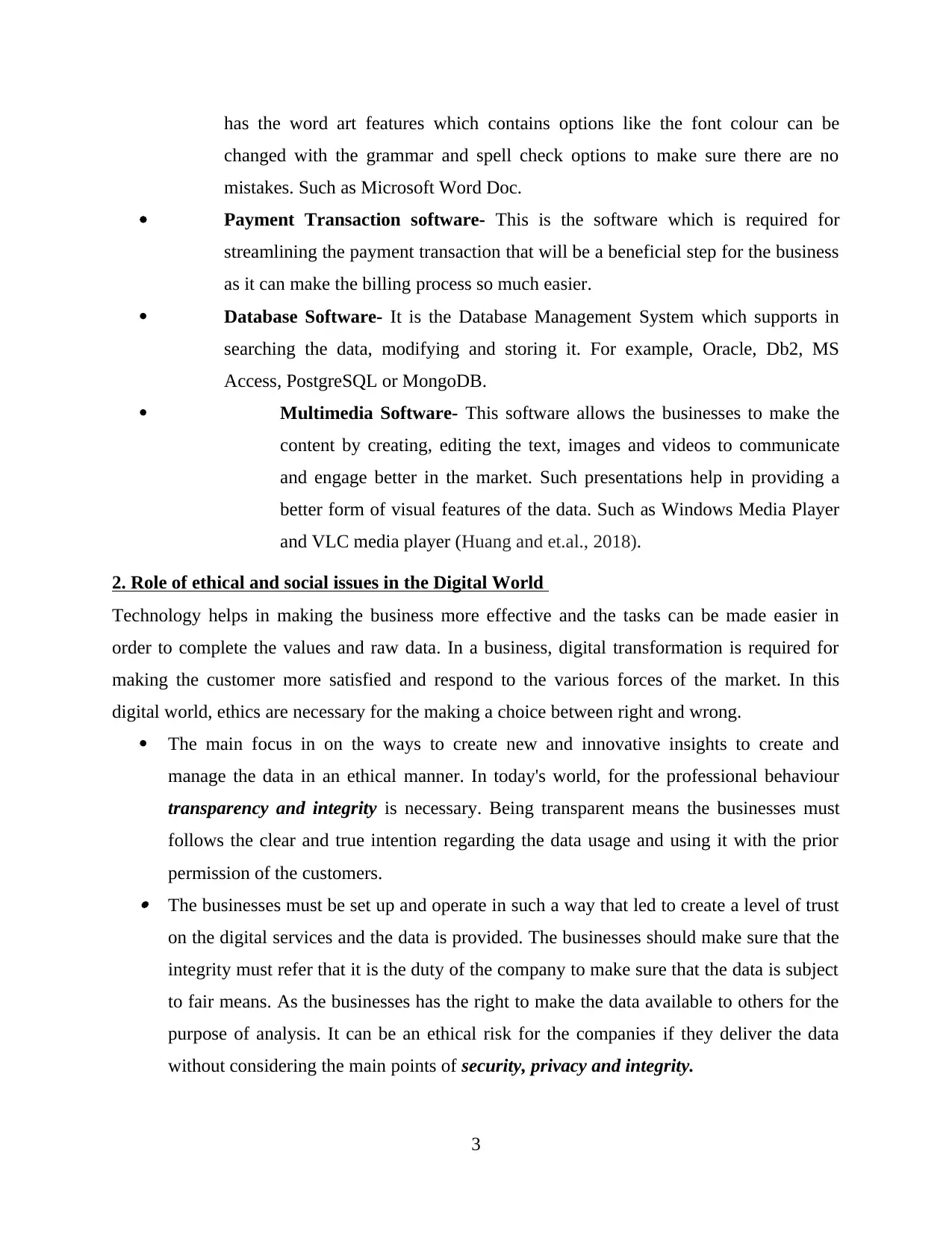
has the word art features which contains options like the font colour can be
changed with the grammar and spell check options to make sure there are no
mistakes. Such as Microsoft Word Doc.
Payment Transaction software- This is the software which is required for
streamlining the payment transaction that will be a beneficial step for the business
as it can make the billing process so much easier.
Database Software- It is the Database Management System which supports in
searching the data, modifying and storing it. For example, Oracle, Db2, MS
Access, PostgreSQL or MongoDB.
Multimedia Software- This software allows the businesses to make the
content by creating, editing the text, images and videos to communicate
and engage better in the market. Such presentations help in providing a
better form of visual features of the data. Such as Windows Media Player
and VLC media player (Huang and et.al., 2018).
2. Role of ethical and social issues in the Digital World
Technology helps in making the business more effective and the tasks can be made easier in
order to complete the values and raw data. In a business, digital transformation is required for
making the customer more satisfied and respond to the various forces of the market. In this
digital world, ethics are necessary for the making a choice between right and wrong.
The main focus in on the ways to create new and innovative insights to create and
manage the data in an ethical manner. In today's world, for the professional behaviour
transparency and integrity is necessary. Being transparent means the businesses must
follows the clear and true intention regarding the data usage and using it with the prior
permission of the customers. The businesses must be set up and operate in such a way that led to create a level of trust
on the digital services and the data is provided. The businesses should make sure that the
integrity must refer that it is the duty of the company to make sure that the data is subject
to fair means. As the businesses has the right to make the data available to others for the
purpose of analysis. It can be an ethical risk for the companies if they deliver the data
without considering the main points of security, privacy and integrity.
3
changed with the grammar and spell check options to make sure there are no
mistakes. Such as Microsoft Word Doc.
Payment Transaction software- This is the software which is required for
streamlining the payment transaction that will be a beneficial step for the business
as it can make the billing process so much easier.
Database Software- It is the Database Management System which supports in
searching the data, modifying and storing it. For example, Oracle, Db2, MS
Access, PostgreSQL or MongoDB.
Multimedia Software- This software allows the businesses to make the
content by creating, editing the text, images and videos to communicate
and engage better in the market. Such presentations help in providing a
better form of visual features of the data. Such as Windows Media Player
and VLC media player (Huang and et.al., 2018).
2. Role of ethical and social issues in the Digital World
Technology helps in making the business more effective and the tasks can be made easier in
order to complete the values and raw data. In a business, digital transformation is required for
making the customer more satisfied and respond to the various forces of the market. In this
digital world, ethics are necessary for the making a choice between right and wrong.
The main focus in on the ways to create new and innovative insights to create and
manage the data in an ethical manner. In today's world, for the professional behaviour
transparency and integrity is necessary. Being transparent means the businesses must
follows the clear and true intention regarding the data usage and using it with the prior
permission of the customers. The businesses must be set up and operate in such a way that led to create a level of trust
on the digital services and the data is provided. The businesses should make sure that the
integrity must refer that it is the duty of the company to make sure that the data is subject
to fair means. As the businesses has the right to make the data available to others for the
purpose of analysis. It can be an ethical risk for the companies if they deliver the data
without considering the main points of security, privacy and integrity.
3
⊘ This is a preview!⊘
Do you want full access?
Subscribe today to unlock all pages.

Trusted by 1+ million students worldwide
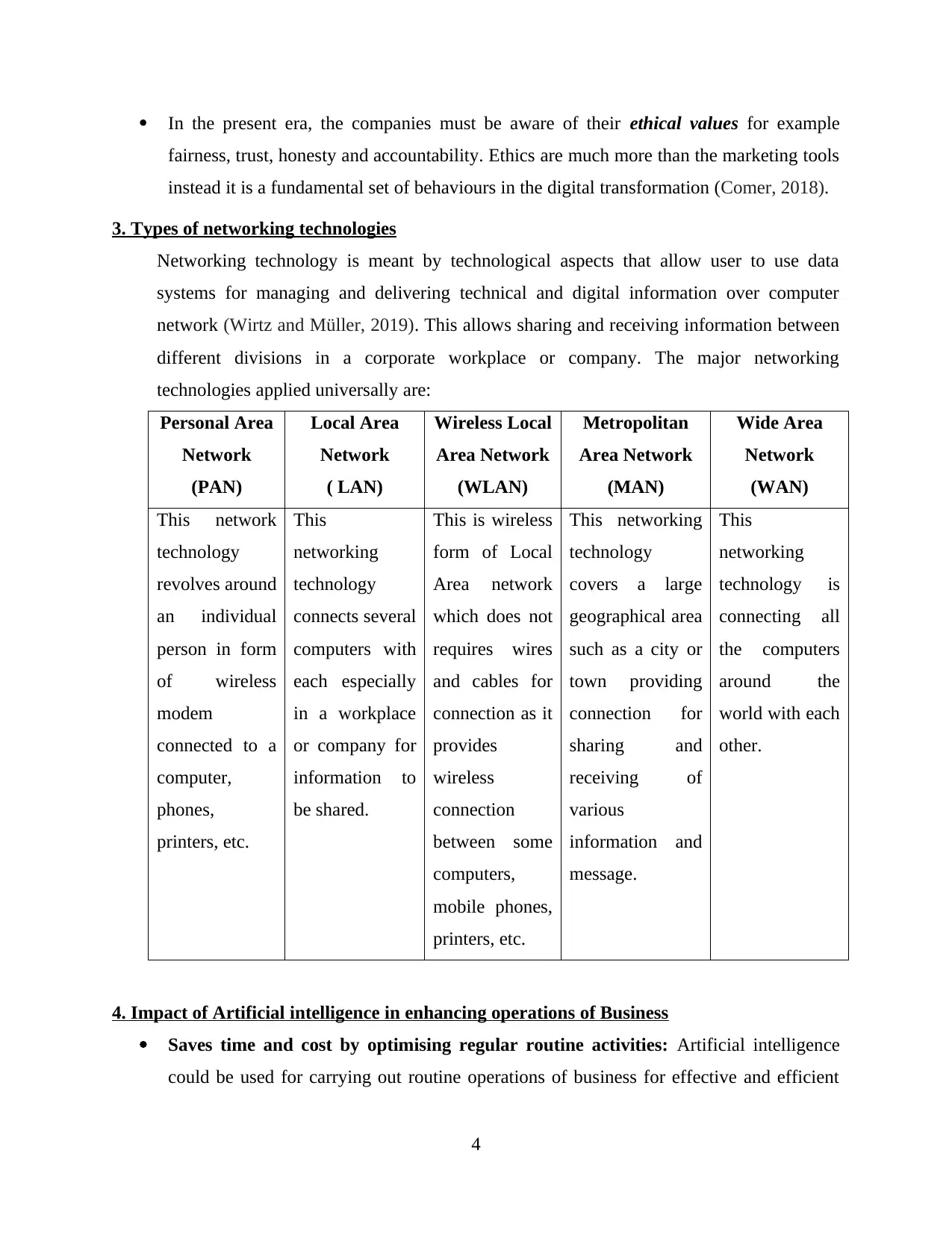
In the present era, the companies must be aware of their ethical values for example
fairness, trust, honesty and accountability. Ethics are much more than the marketing tools
instead it is a fundamental set of behaviours in the digital transformation (Comer, 2018).
3. Types of networking technologies
Networking technology is meant by technological aspects that allow user to use data
systems for managing and delivering technical and digital information over computer
network (Wirtz and Müller, 2019). This allows sharing and receiving information between
different divisions in a corporate workplace or company. The major networking
technologies applied universally are:
Personal Area
Network
(PAN)
Local Area
Network
( LAN)
Wireless Local
Area Network
(WLAN)
Metropolitan
Area Network
(MAN)
Wide Area
Network
(WAN)
This network
technology
revolves around
an individual
person in form
of wireless
modem
connected to a
computer,
phones,
printers, etc.
This
networking
technology
connects several
computers with
each especially
in a workplace
or company for
information to
be shared.
This is wireless
form of Local
Area network
which does not
requires wires
and cables for
connection as it
provides
wireless
connection
between some
computers,
mobile phones,
printers, etc.
This networking
technology
covers a large
geographical area
such as a city or
town providing
connection for
sharing and
receiving of
various
information and
message.
This
networking
technology is
connecting all
the computers
around the
world with each
other.
4. Impact of Artificial intelligence in enhancing operations of Business
Saves time and cost by optimising regular routine activities: Artificial intelligence
could be used for carrying out routine operations of business for effective and efficient
4
fairness, trust, honesty and accountability. Ethics are much more than the marketing tools
instead it is a fundamental set of behaviours in the digital transformation (Comer, 2018).
3. Types of networking technologies
Networking technology is meant by technological aspects that allow user to use data
systems for managing and delivering technical and digital information over computer
network (Wirtz and Müller, 2019). This allows sharing and receiving information between
different divisions in a corporate workplace or company. The major networking
technologies applied universally are:
Personal Area
Network
(PAN)
Local Area
Network
( LAN)
Wireless Local
Area Network
(WLAN)
Metropolitan
Area Network
(MAN)
Wide Area
Network
(WAN)
This network
technology
revolves around
an individual
person in form
of wireless
modem
connected to a
computer,
phones,
printers, etc.
This
networking
technology
connects several
computers with
each especially
in a workplace
or company for
information to
be shared.
This is wireless
form of Local
Area network
which does not
requires wires
and cables for
connection as it
provides
wireless
connection
between some
computers,
mobile phones,
printers, etc.
This networking
technology
covers a large
geographical area
such as a city or
town providing
connection for
sharing and
receiving of
various
information and
message.
This
networking
technology is
connecting all
the computers
around the
world with each
other.
4. Impact of Artificial intelligence in enhancing operations of Business
Saves time and cost by optimising regular routine activities: Artificial intelligence
could be used for carrying out routine operations of business for effective and efficient
4
Paraphrase This Document
Need a fresh take? Get an instant paraphrase of this document with our AI Paraphraser
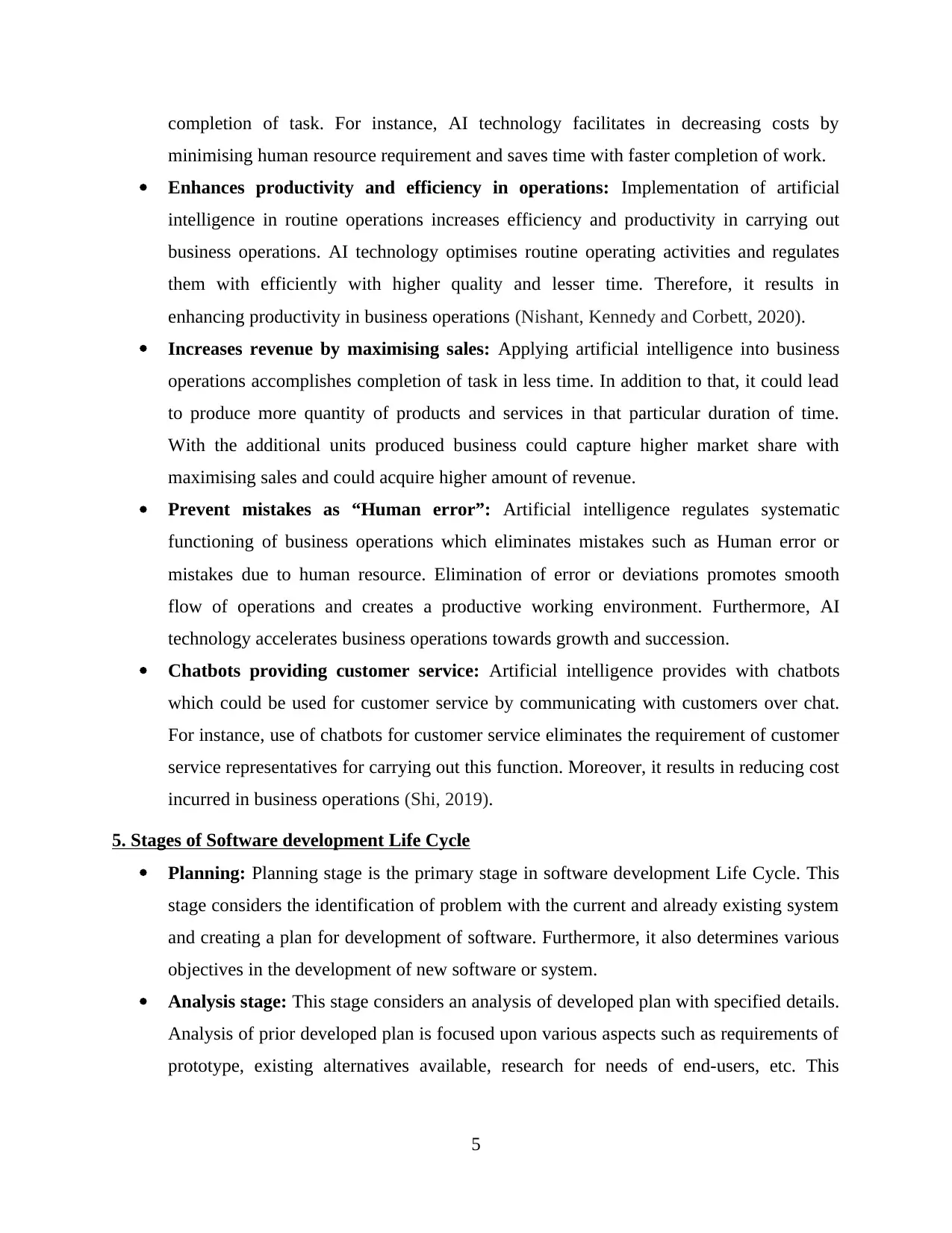
completion of task. For instance, AI technology facilitates in decreasing costs by
minimising human resource requirement and saves time with faster completion of work.
Enhances productivity and efficiency in operations: Implementation of artificial
intelligence in routine operations increases efficiency and productivity in carrying out
business operations. AI technology optimises routine operating activities and regulates
them with efficiently with higher quality and lesser time. Therefore, it results in
enhancing productivity in business operations (Nishant, Kennedy and Corbett, 2020).
Increases revenue by maximising sales: Applying artificial intelligence into business
operations accomplishes completion of task in less time. In addition to that, it could lead
to produce more quantity of products and services in that particular duration of time.
With the additional units produced business could capture higher market share with
maximising sales and could acquire higher amount of revenue.
Prevent mistakes as “Human error”: Artificial intelligence regulates systematic
functioning of business operations which eliminates mistakes such as Human error or
mistakes due to human resource. Elimination of error or deviations promotes smooth
flow of operations and creates a productive working environment. Furthermore, AI
technology accelerates business operations towards growth and succession.
Chatbots providing customer service: Artificial intelligence provides with chatbots
which could be used for customer service by communicating with customers over chat.
For instance, use of chatbots for customer service eliminates the requirement of customer
service representatives for carrying out this function. Moreover, it results in reducing cost
incurred in business operations (Shi, 2019).
5. Stages of Software development Life Cycle
Planning: Planning stage is the primary stage in software development Life Cycle. This
stage considers the identification of problem with the current and already existing system
and creating a plan for development of software. Furthermore, it also determines various
objectives in the development of new software or system.
Analysis stage: This stage considers an analysis of developed plan with specified details.
Analysis of prior developed plan is focused upon various aspects such as requirements of
prototype, existing alternatives available, research for needs of end-users, etc. This
5
minimising human resource requirement and saves time with faster completion of work.
Enhances productivity and efficiency in operations: Implementation of artificial
intelligence in routine operations increases efficiency and productivity in carrying out
business operations. AI technology optimises routine operating activities and regulates
them with efficiently with higher quality and lesser time. Therefore, it results in
enhancing productivity in business operations (Nishant, Kennedy and Corbett, 2020).
Increases revenue by maximising sales: Applying artificial intelligence into business
operations accomplishes completion of task in less time. In addition to that, it could lead
to produce more quantity of products and services in that particular duration of time.
With the additional units produced business could capture higher market share with
maximising sales and could acquire higher amount of revenue.
Prevent mistakes as “Human error”: Artificial intelligence regulates systematic
functioning of business operations which eliminates mistakes such as Human error or
mistakes due to human resource. Elimination of error or deviations promotes smooth
flow of operations and creates a productive working environment. Furthermore, AI
technology accelerates business operations towards growth and succession.
Chatbots providing customer service: Artificial intelligence provides with chatbots
which could be used for customer service by communicating with customers over chat.
For instance, use of chatbots for customer service eliminates the requirement of customer
service representatives for carrying out this function. Moreover, it results in reducing cost
incurred in business operations (Shi, 2019).
5. Stages of Software development Life Cycle
Planning: Planning stage is the primary stage in software development Life Cycle. This
stage considers the identification of problem with the current and already existing system
and creating a plan for development of software. Furthermore, it also determines various
objectives in the development of new software or system.
Analysis stage: This stage considers an analysis of developed plan with specified details.
Analysis of prior developed plan is focused upon various aspects such as requirements of
prototype, existing alternatives available, research for needs of end-users, etc. This
5
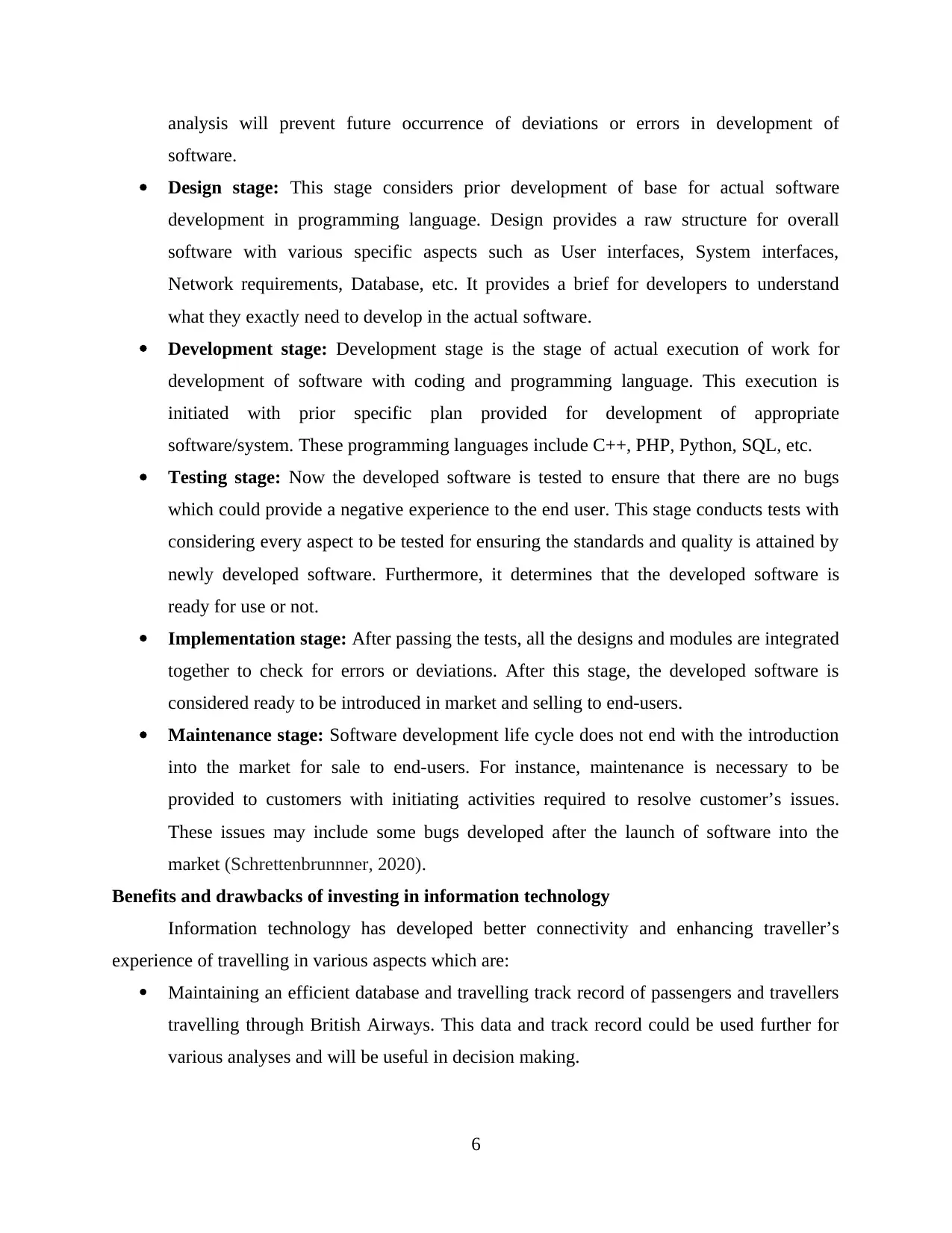
analysis will prevent future occurrence of deviations or errors in development of
software.
Design stage: This stage considers prior development of base for actual software
development in programming language. Design provides a raw structure for overall
software with various specific aspects such as User interfaces, System interfaces,
Network requirements, Database, etc. It provides a brief for developers to understand
what they exactly need to develop in the actual software.
Development stage: Development stage is the stage of actual execution of work for
development of software with coding and programming language. This execution is
initiated with prior specific plan provided for development of appropriate
software/system. These programming languages include C++, PHP, Python, SQL, etc.
Testing stage: Now the developed software is tested to ensure that there are no bugs
which could provide a negative experience to the end user. This stage conducts tests with
considering every aspect to be tested for ensuring the standards and quality is attained by
newly developed software. Furthermore, it determines that the developed software is
ready for use or not.
Implementation stage: After passing the tests, all the designs and modules are integrated
together to check for errors or deviations. After this stage, the developed software is
considered ready to be introduced in market and selling to end-users.
Maintenance stage: Software development life cycle does not end with the introduction
into the market for sale to end-users. For instance, maintenance is necessary to be
provided to customers with initiating activities required to resolve customer’s issues.
These issues may include some bugs developed after the launch of software into the
market (Schrettenbrunnner, 2020).
Benefits and drawbacks of investing in information technology
Information technology has developed better connectivity and enhancing traveller’s
experience of travelling in various aspects which are:
Maintaining an efficient database and travelling track record of passengers and travellers
travelling through British Airways. This data and track record could be used further for
various analyses and will be useful in decision making.
6
software.
Design stage: This stage considers prior development of base for actual software
development in programming language. Design provides a raw structure for overall
software with various specific aspects such as User interfaces, System interfaces,
Network requirements, Database, etc. It provides a brief for developers to understand
what they exactly need to develop in the actual software.
Development stage: Development stage is the stage of actual execution of work for
development of software with coding and programming language. This execution is
initiated with prior specific plan provided for development of appropriate
software/system. These programming languages include C++, PHP, Python, SQL, etc.
Testing stage: Now the developed software is tested to ensure that there are no bugs
which could provide a negative experience to the end user. This stage conducts tests with
considering every aspect to be tested for ensuring the standards and quality is attained by
newly developed software. Furthermore, it determines that the developed software is
ready for use or not.
Implementation stage: After passing the tests, all the designs and modules are integrated
together to check for errors or deviations. After this stage, the developed software is
considered ready to be introduced in market and selling to end-users.
Maintenance stage: Software development life cycle does not end with the introduction
into the market for sale to end-users. For instance, maintenance is necessary to be
provided to customers with initiating activities required to resolve customer’s issues.
These issues may include some bugs developed after the launch of software into the
market (Schrettenbrunnner, 2020).
Benefits and drawbacks of investing in information technology
Information technology has developed better connectivity and enhancing traveller’s
experience of travelling in various aspects which are:
Maintaining an efficient database and travelling track record of passengers and travellers
travelling through British Airways. This data and track record could be used further for
various analyses and will be useful in decision making.
6
⊘ This is a preview!⊘
Do you want full access?
Subscribe today to unlock all pages.

Trusted by 1+ million students worldwide
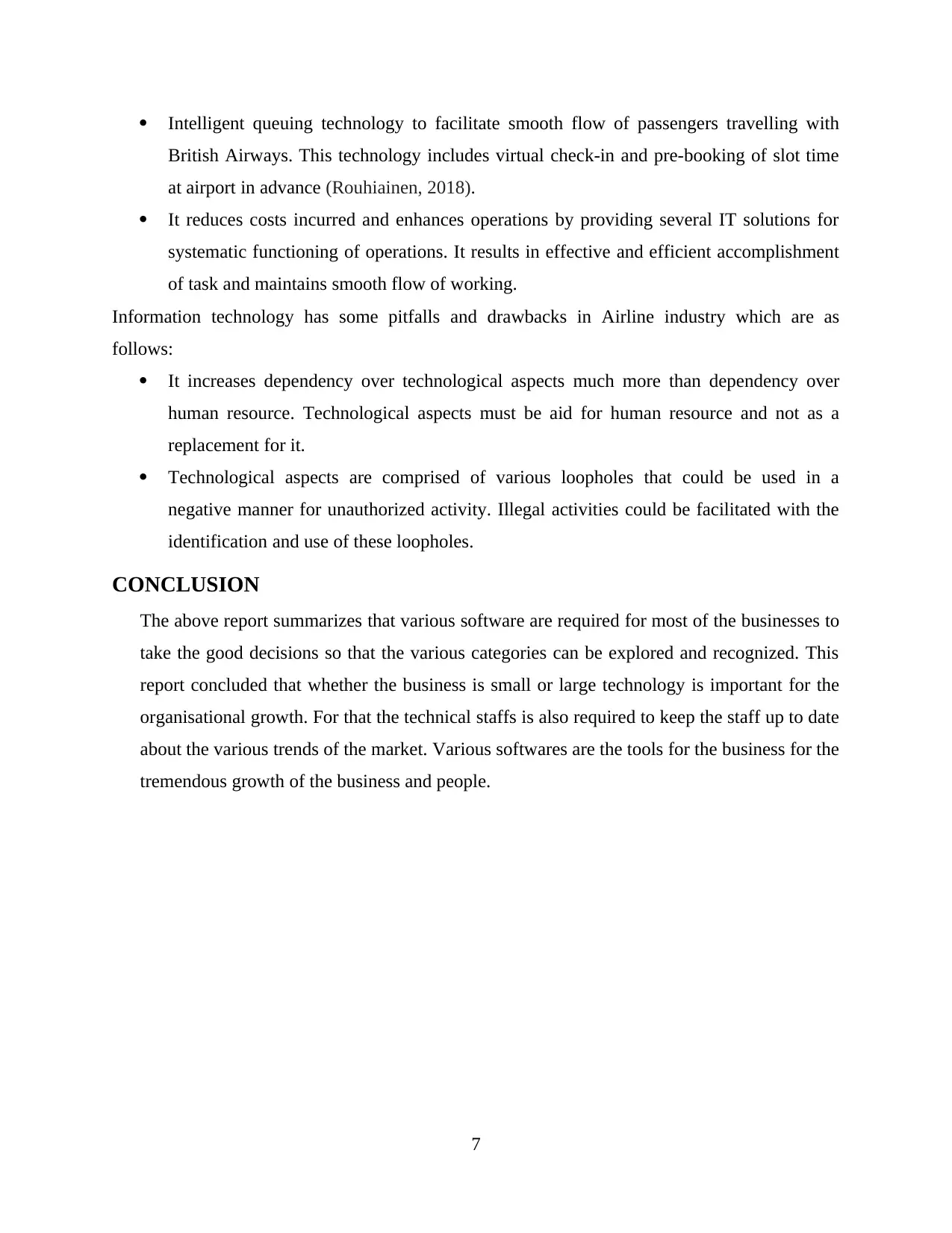
Intelligent queuing technology to facilitate smooth flow of passengers travelling with
British Airways. This technology includes virtual check-in and pre-booking of slot time
at airport in advance (Rouhiainen, 2018).
It reduces costs incurred and enhances operations by providing several IT solutions for
systematic functioning of operations. It results in effective and efficient accomplishment
of task and maintains smooth flow of working.
Information technology has some pitfalls and drawbacks in Airline industry which are as
follows:
It increases dependency over technological aspects much more than dependency over
human resource. Technological aspects must be aid for human resource and not as a
replacement for it.
Technological aspects are comprised of various loopholes that could be used in a
negative manner for unauthorized activity. Illegal activities could be facilitated with the
identification and use of these loopholes.
CONCLUSION
The above report summarizes that various software are required for most of the businesses to
take the good decisions so that the various categories can be explored and recognized. This
report concluded that whether the business is small or large technology is important for the
organisational growth. For that the technical staffs is also required to keep the staff up to date
about the various trends of the market. Various softwares are the tools for the business for the
tremendous growth of the business and people.
7
British Airways. This technology includes virtual check-in and pre-booking of slot time
at airport in advance (Rouhiainen, 2018).
It reduces costs incurred and enhances operations by providing several IT solutions for
systematic functioning of operations. It results in effective and efficient accomplishment
of task and maintains smooth flow of working.
Information technology has some pitfalls and drawbacks in Airline industry which are as
follows:
It increases dependency over technological aspects much more than dependency over
human resource. Technological aspects must be aid for human resource and not as a
replacement for it.
Technological aspects are comprised of various loopholes that could be used in a
negative manner for unauthorized activity. Illegal activities could be facilitated with the
identification and use of these loopholes.
CONCLUSION
The above report summarizes that various software are required for most of the businesses to
take the good decisions so that the various categories can be explored and recognized. This
report concluded that whether the business is small or large technology is important for the
organisational growth. For that the technical staffs is also required to keep the staff up to date
about the various trends of the market. Various softwares are the tools for the business for the
tremendous growth of the business and people.
7
Paraphrase This Document
Need a fresh take? Get an instant paraphrase of this document with our AI Paraphraser
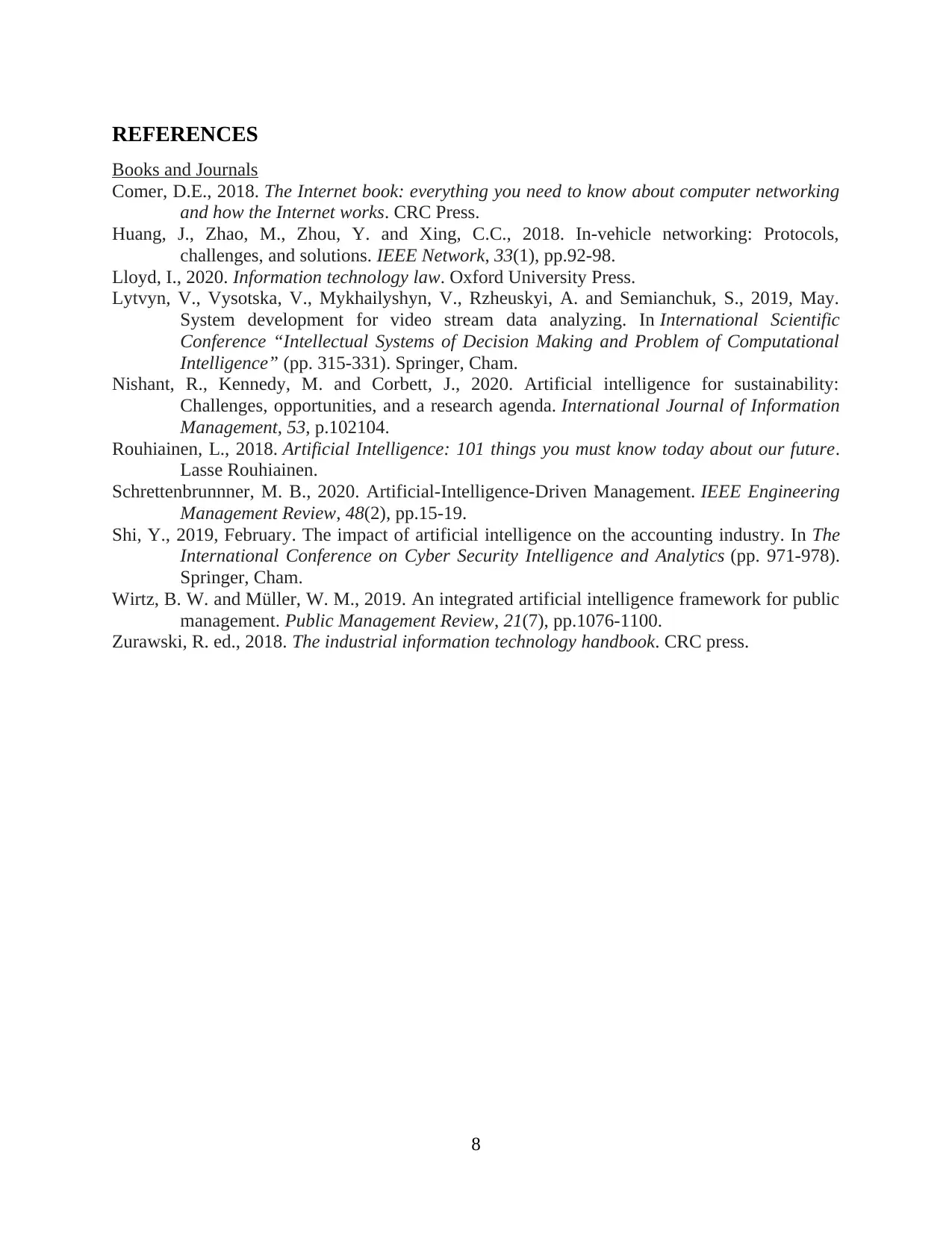
REFERENCES
Books and Journals
Comer, D.E., 2018. The Internet book: everything you need to know about computer networking
and how the Internet works. CRC Press.
Huang, J., Zhao, M., Zhou, Y. and Xing, C.C., 2018. In-vehicle networking: Protocols,
challenges, and solutions. IEEE Network, 33(1), pp.92-98.
Lloyd, I., 2020. Information technology law. Oxford University Press.
Lytvyn, V., Vysotska, V., Mykhailyshyn, V., Rzheuskyi, A. and Semianchuk, S., 2019, May.
System development for video stream data analyzing. In International Scientific
Conference “Intellectual Systems of Decision Making and Problem of Computational
Intelligence” (pp. 315-331). Springer, Cham.
Nishant, R., Kennedy, M. and Corbett, J., 2020. Artificial intelligence for sustainability:
Challenges, opportunities, and a research agenda. International Journal of Information
Management, 53, p.102104.
Rouhiainen, L., 2018. Artificial Intelligence: 101 things you must know today about our future.
Lasse Rouhiainen.
Schrettenbrunnner, M. B., 2020. Artificial-Intelligence-Driven Management. IEEE Engineering
Management Review, 48(2), pp.15-19.
Shi, Y., 2019, February. The impact of artificial intelligence on the accounting industry. In The
International Conference on Cyber Security Intelligence and Analytics (pp. 971-978).
Springer, Cham.
Wirtz, B. W. and Müller, W. M., 2019. An integrated artificial intelligence framework for public
management. Public Management Review, 21(7), pp.1076-1100.
Zurawski, R. ed., 2018. The industrial information technology handbook. CRC press.
8
Books and Journals
Comer, D.E., 2018. The Internet book: everything you need to know about computer networking
and how the Internet works. CRC Press.
Huang, J., Zhao, M., Zhou, Y. and Xing, C.C., 2018. In-vehicle networking: Protocols,
challenges, and solutions. IEEE Network, 33(1), pp.92-98.
Lloyd, I., 2020. Information technology law. Oxford University Press.
Lytvyn, V., Vysotska, V., Mykhailyshyn, V., Rzheuskyi, A. and Semianchuk, S., 2019, May.
System development for video stream data analyzing. In International Scientific
Conference “Intellectual Systems of Decision Making and Problem of Computational
Intelligence” (pp. 315-331). Springer, Cham.
Nishant, R., Kennedy, M. and Corbett, J., 2020. Artificial intelligence for sustainability:
Challenges, opportunities, and a research agenda. International Journal of Information
Management, 53, p.102104.
Rouhiainen, L., 2018. Artificial Intelligence: 101 things you must know today about our future.
Lasse Rouhiainen.
Schrettenbrunnner, M. B., 2020. Artificial-Intelligence-Driven Management. IEEE Engineering
Management Review, 48(2), pp.15-19.
Shi, Y., 2019, February. The impact of artificial intelligence on the accounting industry. In The
International Conference on Cyber Security Intelligence and Analytics (pp. 971-978).
Springer, Cham.
Wirtz, B. W. and Müller, W. M., 2019. An integrated artificial intelligence framework for public
management. Public Management Review, 21(7), pp.1076-1100.
Zurawski, R. ed., 2018. The industrial information technology handbook. CRC press.
8
1 out of 11
Related Documents
Your All-in-One AI-Powered Toolkit for Academic Success.
+13062052269
info@desklib.com
Available 24*7 on WhatsApp / Email
![[object Object]](/_next/static/media/star-bottom.7253800d.svg)
Unlock your academic potential
Copyright © 2020–2025 A2Z Services. All Rights Reserved. Developed and managed by ZUCOL.



